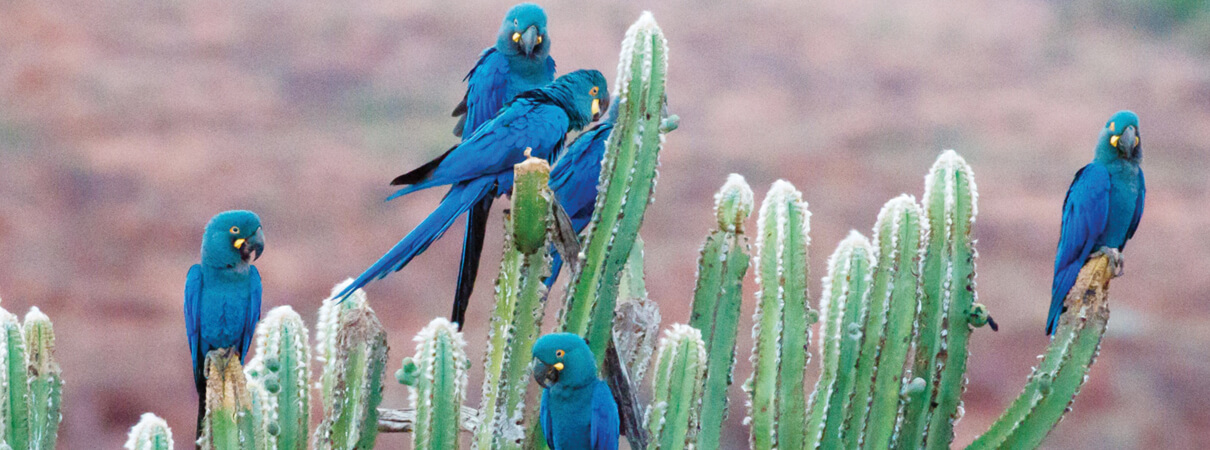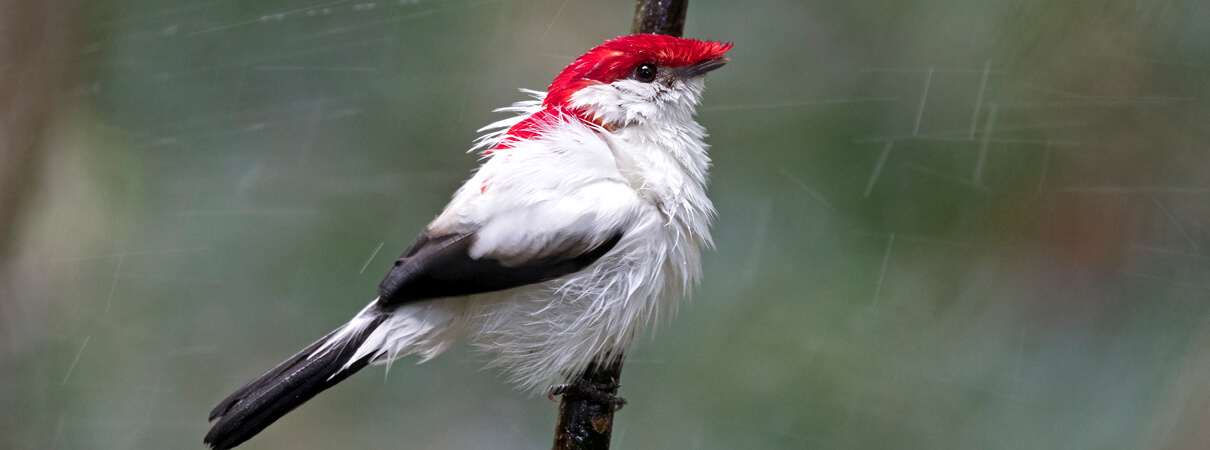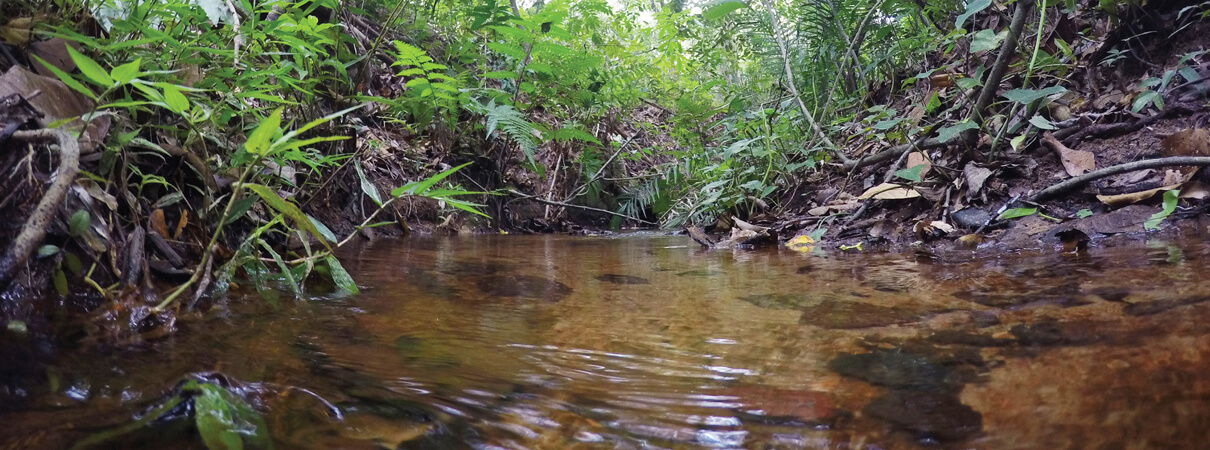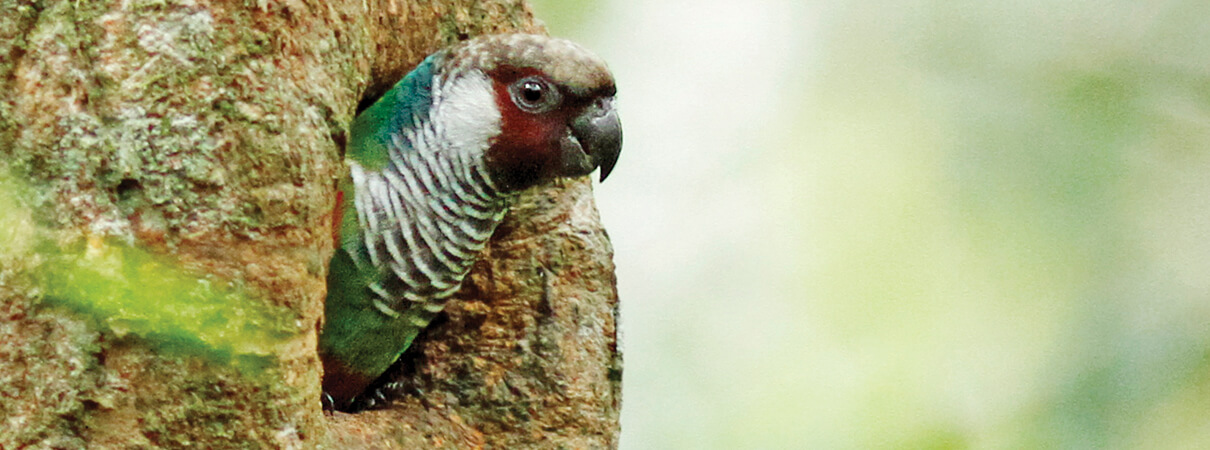Into Brazil: ABC's Work to Save Some of the World's Rarest Birds
The reality is clear: Brazil is home to some of the world's rarest birds, with the highest number of threatened birds in the world. Nowhere else on our planet will we find as many bird species in need of immediate and effective conservation action.

Brazil is home to more threatened birds than any other country in the world. Many species, such as these Lear's Macaws, are restricted in both geography and habitat. Photo by Maggie Forrester
But there is another reality we cannot ignore. Brazil's wealth is just one-fifth of other developed nations, while Brazil's investment in conservation is barely one-twentieth of those same nations. Why the difference? Some say this is because Brazil's charity-minded individuals tend to support organizations that address poverty rather than conservation and other issues. Others suggest that a lack of conservation awareness stunts giving. Or, perhaps conservation philanthropy has simply not yet caught up with Brazil's economic emergence.
Whatever the reasons, Brazil's wildlife is in dire need of conservation action.
The Long Road to Brazil
Twenty years ago, I knew none of this. I was not yet involved with American Bird Conservancy (ABC) — which George Fenwick had founded only a few years prior — and had just moved to Bolivia. I wanted to contribute to conservation, and believed the best way to do this was to live in the country where the action would be happening. I also wanted to work in a country that would benefit from my work, and where I would not be taking away a job from a citizen of that country.
Bolivia was a perfect fit. The country was home to numerous threatened birds, and yet there was very little happening for bird conservation at the time. Brazil, with its comparative wealth, did not need my help. Or so I thought.
At the time, Brazil seemed well prepared to address its own conservation issues. The country was more developed than many of its neighbors. It had a larger pool of people trained in biology and conservation. And Brazil was in the midst of an economic boom that should have ultimately helped support conservation measures.
But as the years moved on, both I and American Bird Conservancy — still working independently — started to notice that Brazil's economic growth was being matched by the expansion of their list of threatened birds. Greater wealth was not translating into more conservation.
Saving Some of the Rarest Birds
In 2012, a fortunate serendipity arose between ABC and me.
A chance trip brought me to Dulles International Airport, near ABC's headquarters in The Plains, Virginia. And so I took a trip out to meet the Fenwicks and talk about our mutual interest in Brazil.

The Mata do Passarinho Reserve was established to save Stresemann's Bristlefront from extinction. Deforestation, as seen here, remains the greatest threat facing the critically endangered bird. Photo by Biodiversitas
At the time, ABC's involvement in Brazil centered around three main projects: establishing the Mata do Passarinho Reserve for the critically endangered Stresemann's Bristlefront and expanding the Canudos Biological Station Reserve for the critically endangered Lear's Macaw, both with partner Biodiversitas; and strengthening land protection at the Guapi Assu Ecological Reserve (REGUA). But by the end of our conversation, George agreed it was time for ABC to greatly increase its investment and we decided to try an experiment: Working as a contractor, I would develop a Brazil bird conservation strategy with ABC over the next six months.
The assignment turned into detective work for me to uncover the hidden secrets of Brazil's bird conservation priorities. I found that the accessible, English-published literature only scratched the surface with regards to the complexities of Brazil's threatened birds. So much more information was unpublished, residing securely in the heads of Brazilian ornithologists, bird guides, and birdwatchers.
I also discovered that the information published in Portuguese had been overlooked by global threatened species assessments. For example, I found that the Murici Ecological Station — which we thought had been responsibly protected since 2001 — had been basically ignored for 13 years, with all of its land still held in private ownership, and half of it still grazed by cattle. It was the birdwatchers who noticed the problem.
Sign up for ABC's eNews to learn how you can help protect birds
After six months of sleuthing, we had enough information to know one thing for sure: Brazil's birds needed ABC now more than ever. We could not let any more birds slip away into extinction without anyone taking notice. And so we extended my contract with ABC so that we could work together to make a difference for the many other rare bird species found in Brazil.
Getting to Know Brazil
In a country where 24 species are considered critically endangered, it is important to deeply understand the species at stake — including their habitat needs and the threats they face — and prioritize accordingly.
Brazil is home to an almost unbelievable abundance of biodiversity. Its plentiful rain and warm climate help sustain the world's largest and most biologically diverse rainforest — the Amazon Rainforest — which harbors one-tenth of all the species found in the entire world, including nearly 1,300 known species of birds.

The highly threatened Araripe Manakin is a priority species for ABC. Fewer than 1,000 of these spectacular red-and-white birds remain in the wild, and all of them are found in only one location: a narrow strip of forest on the slopes of Brazil's Araripe Plateau. Photo by Ciro Albano
Much of Brazil's coastline once supported a second expansive forest — the Atlantic Forest — which has now been reduced to a fragment of its historic range. Despite the extensive habitat loss, the Atlantic Forest still supports more than 900 species of birds, many of which are found nowhere else in the world. Overall, Brazil is home to 13 percent of all known species, and yet some biologists estimate that 50 percent of these species could become extinct by 2020.
ABC developed a strategy based on this knowledge and the extinction patterns in Brazil — especially those seen in the highly fragmented Atlantic Forest, where we would ultimately invest most of our energy. Because, although the Amazon Rainforest is better known, it is actually much less threatened and home to far fewer endangered birds than the Atlantic Forest.
We would identify those rarest birds that most need our help, find and protect their essential habitat, and forge strong alliances with Brazilian conservation partners wherever possible. And, of course, we would continue the important work that ABC had already begun.
Partners, Preserves, and Promise for the Future
In 2013, ABC began to seriously expand our work and investment in Brazil. Over the 18-year period prior to 2013, ABC's investment in Brazil totaled $735,000. In the four years since, we have doubled that number.
With our new strategy in place, we continued our efforts with Biodiversitas and also forged new partnerships with two nonprofits: SAVE Brasil and Aquasis. Together with these partners, we began to ramp up real, on-the-ground conservation for Brazil's birds and their essential habitat.
Some of our work is guided by species. For example, we've identified the highly threatened Araripe Manakin as a priority. Fewer than 1,000 of these spectacular red-and-white birds remain in the wild, and all of them are found in only one location: a narrow strip of forest on the slopes of Brazil's Araripe Plateau. The species is threatened primarily by a lack of suitable breeding sites. In an effort to aid their recovery, ABC helped Aquasis purchase 140 acres of prime breeding habitat for these birds in 2014, establishing the Oasis Araripe Reserve. We repeated the feat in 2016 with the purchase of another 170 acres, more than doubling the size of the existing reserve and connecting it with the much larger Araripe National Forest.

Brazil's Oasis Araripe Reserve includes riverside habitat used by the critically endangered Araripe Manakin. Photo by Fabio Nunes
Aquasis' Araripe Manakin project — coordinated by the wonder duo of Weber Silva and his wife Karina Linhares — should be the standard for conservation projects designed to save a species from extinction. Through meticulous research, Aquasis now knows where the species lives, and its preferred habitat, food, and nesting sites. Thanks to Aquasis' dedicated team, we now know every ingredient necessary to ensure the health of this species, which includes intricate management of streams and planting the right kind of vegetation to create an optimal breeding environment. Their efforts guided our land acquisition choices in 2014 and again in 2016, and will continue to guide our efforts to protect the Araripe Manakin in the years to come.
Other species-focused conservation efforts include Aquasis' amazingly successful conservation program with the Grey-breasted Parakeet (a community-based nest box program that has doubled the size of the population) and SAVE Brasil's work to conserve the critically endangered Cherry-throated Tanager and São Paulo Marsh Antwren — all of which have been supported by ABC. Most recently, we've supported SAVE Brasil's actions to create an emergency conservation plan for the Alagoas Antwren, a species whose population has dwindled to the point that the last remaining birds live in only one small forest fragment in Murici, a municipality in Brazil's coastal state of Alagoas.

Aquasis' amazingly successful conservation and community-based nest box program with the Grey-breasted Parakeet has doubled the size of the species' population. Photo by Fabio Nunes
In other cases, we and our partners focus our efforts on specific ecosystems — which will of course ultimately support the birds as well. SAVE Brasil, for example, has always focused its attention on Brazil's highly threatened Atlantic Forest. Today, biologists estimate that less than 10 percent of the ecosystem remains, all of it in scattered fragments of forest surrounded by agriculture and development. No other tropical forest has suffered as much devastation as this little-known and once-vast ecosystem.
SAVE Brasil is alone among Brazil's conservation groups to insist on improved conservation measures for the Murici region's Atlantic Forest fragments, where the last of the world's Alagoas Antwrens find shelter. The group is also working to expand protections for another important Atlantic Forest fragment at Serra do Urubu by investing in reserves, assessing the surrounding areas, and assisting with the long- term sustainable management of the reserve. ABC is honored to support these efforts, most recently with a successful campaign that raised more than $200,000 to support the expansion of the Serra do Urubu reserve.
It was less than five years ago that George Fenwick first agreed to the six-month test-run that would ultimately evolve into a much larger involvement in Brazil for ABC. Though my own involvement with ABC has evolved since then, I continue with my sleuthing, always seeking to learn more that will help us help Brazil's rarest birds. Most recently, this includes ABC's support of a well-coordinated and ongoing search by the Instituto Butantan for the Kinglet Calyptura, a “lost” species that has not been seen in the wild since 1996. Findings from this work may help save this and other rare species — a new protected area could be on the horizon.
And so we and our partners continue, one species and forest fragment at a time. With the help of our partners, we may ultimately add another entry to Brazil's list of exceptional statistics: that of being the country that has saved more of the rarest birds than anywhere else in the world.
Author's Note: Our successes in Brazil — and indeed, everywhere we work — would not be possible without our generous members and supporters.
Since the start of our involvement in Brazil, your donations have helped us raise more than $2 million in support of conservation projects in Brazil. Those donations allow us to support creative, productive, and strategic projects that we hope will ultimately halt bird extinctions in Brazil.
Thank you. Your support sustains us and the birds.
 Bennett Hennessey is an independent contractor representing ABC in Brazil since 2012, where he works to establish and manage conservation projects with ABC's Brazilian partners. Prior to his work in Brazil, he did field work in the Congo, and spent 20 years working and living in Bolivia. Bennett lives with his wife in Santa Cruz, Bolivia, where he also works for ABC's Bolivian partner Asociación Armonía and pioneers new bird feeding techniques in his backyard.
Bennett Hennessey is an independent contractor representing ABC in Brazil since 2012, where he works to establish and manage conservation projects with ABC's Brazilian partners. Prior to his work in Brazil, he did field work in the Congo, and spent 20 years working and living in Bolivia. Bennett lives with his wife in Santa Cruz, Bolivia, where he also works for ABC's Bolivian partner Asociación Armonía and pioneers new bird feeding techniques in his backyard.


















































